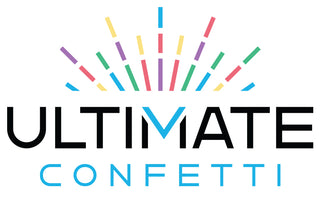
8 Interesting Confetti Facts You Didn't Know
Most people associate the sight of confetti with the knowledge that a party’s afoot, but not everyone knows where this tradition comes from. In its modern form, confetti has been used for almost 150 years at celebrations, parades, and festivals. However, the true history of confetti starts much earlier than that. And while confetti may seem simple at first glance, there’s definitely more to it than meets the eye! Here are eight cool facts about confetti, from its origins to its role in modern-day celebrations:
1. THE FIRST REFERENCE TO CONFETTI IN LITERATURE DATES BACK TO THE 14TH CENTURY.
Italian author Giovanni Boccaccio’s Decameron novellas, which were published from 1313-1365, describe confetti as candy-like confections “made from honey and dried fruit, as well as spices and…seeds or nuts.” Seven centuries later, the sweets Boccaccio was talking about are known as “Jordan almonds” or “dragée,” while “confetti” typically means pieces of paper or reflective plastic that are thrown during celebrations. It’s worth mentioning, though, that Jordan almonds are still occasionally called “Italian Confetti.”
2. CONFETTI, AS WE KNOW IT TODAY, WAS INVENTED BY ITALIAN BUSINESSMAN ENRICO MANGILI IN 1895.
Back in the day, silkworm farmers used perforated pieces of paper as bedding for their worms. Of course, this kind of material created tiny, punched-out pieces of paper as a byproduct. Mangili gathered these paper dots and marketed them as something safe and silly to throw during parades and celebrations in order to have fun and drum up excitement. Before paper confetti was invented, it was normal to throw mud or eggs during special events. Talk about a technological improvement!
3. THE WORD "CONFETTI" DERIVES FROM “CONFICERE,” WHICH IS LATIN FOR “TO CONFECT, COMPOSE, OR MAKE.”
A large number of English words have Latin origins. Interestingly enough, the word “celebrate” comes from “celebrare,” meaning “to honor,” and “festive” comes from “festivus,” meaning “merry, lively, or joyous.” The Romans definitely knew how to have a good time!
4. IN ADDITION TO PAPER, EXTRA FANCY CONFETTI IN THE EARLY 20TH CENTURY WAS SOMETIMES CRAFTED OUT OF SILK AND GOLD.
Gold and silk are shiny, eye-catching, and luxurious, but for most people, these substances are prohibitively expensive to use as party décor. Fortunately, the invention of biaxially-oriented polyethylene terephthalate (BoPET; more commonly known under the brand name “Mylar”) in the mid-20th century has allowed for the creation of confetti with all of the glitz and glam of precious metals and textiles but at a fraction of the cost. Meanwhile, paper has always been a popular choice due to its accessibility and lightweight nature.
5. FOR THE MAJORITY OF THE 20TH CENTURY, HEARTS, CIRCLES, AND STARS WERE THE MOST COMMON CONFETTI SHAPES.
In the mid-1980s, though, more fanciful designs were introduced. So, if you’re planning to throw an 80s-themed party, don’t worry about unique confetti being anachronistic. Just make sure you get the stuff in “totally tubular” colors like neon orange, bright magenta, and electric green!
6. ANOTHER COMMON MATERIAL USED TO CREATE METALLIC CONFETTI IS POLYVINYL CHLORIDE, OR PVC.
Yep, you can get confetti made out the same plastic as the pipes in your bathroom! Though industrial PVC is usually matte white in color, metallized PVC is shiny and reflective. Once again, the end result is confetti that’s reminiscent of precious metals without costing a fortune to produce.
7. THESE DAYS, IT’S POSSIBLE TO FIND CONFETTI IN MORE THAN 2000 DIFFERENT SHAPES.
It’s not limited to plain geometric shapes, either. Balloons, snowflakes, color swirls, words and phrases (like “BABY” or “HAPPY BIRTHDAY”)—and that’s just in OUR product catalog! Improvements in manufacturing technology have allowed for the creation of more sophisticated and delicately cut confetti. Confetti also now comes in a plethora of colors and finishes (shiny, matte, holographic, etc.).
8. TIMES SQUARE NORMALLY DROPS AT LEAST ONE TON OF CONFETTI DURING ITS NEW YEAR’S CELEBRATIONS, WHICH GENERALLY TAKES THE NYC SANITATION DEPARTMENT HOURS TO CLEAN UP.
After the revelers go home, a team of 250 people or more work tirelessly to make Times Square look (reasonably) neat by the time the sun rises on January 1st! Now, here’s the good news: the confetti used in the celebration is made of biodegradable paper, not plastic. That means that the bulk of it can be recycled, and any stray bits that get away from the cleanup crew will not harm the environment (or any urban wildlife).
At the end of the day, you don’t have to be a connoisseur in order to appreciate confetti’s beauty, or the joy it can bring to an event. Still, it’s neat to learn a little more about items that we may take for granted in our daily lives. And if you now have a few pieces of trivia to whip out the next time you’re at a party and there’s a lull in the conversation…well, so much for the better!

Leave a comment